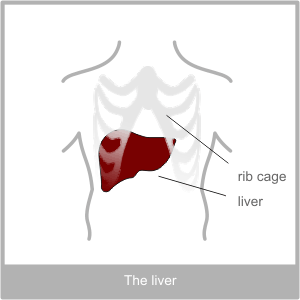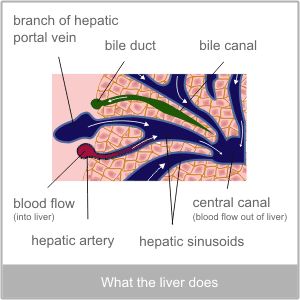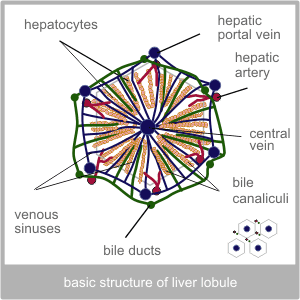The Liver
The liver is the largest vital organ in the body. It is situated under the ribs on the right hand side. From the Western perspective the liver performs literally hundreds of different functions and supports virtually every other organ in the body. This is what makes it so vital to our survival.

The Physiology of the Liver
Nutrient rich blood that has passed through the previous sections of the gastro intestinal tract, enters the liver via the portal vein. It is joined by oxygenated arterial blood coming from the hepatic artery. It is then filtered through the numerous tiny channels of the liver, known as sinusoids. The fact that these sinusoids are so numerous and so small means that the total surface area of the liver, in contact with the blood, is very great and that it can hold and process a large volume at any one time.
If we look closely at the structure of the liver we can see that it is made up of tiny hexagonal lobules. In the centre of the hexagon is the vein that carries blood out of the liver. This central vein is surrounded by a circle of sinusoids that are interspersed with the tiny canals which allow all parts of the liver to drain bile. The blood supply to the liver is situated at the corners of the hexagon. Eventually the blood leaves the liver via the hepatic vein and the bile leaves via the hepatic duct that leads to the duodenum.
 What the Liver does
What the Liver does
As we have already said the liver is involved in many of our bodily functions, and some of these are quite diverse.
Broadly speaking the functions of the liver can be broken down into three:
1. Processing and storing nutrients
2. Protection
3. Recycling
1. Processing and storing nutrients from the blood
The first raft of functions associated with the liver comes from its role in processing the nutrients in the blood delivered by the
gastro-intestinal tract:
 a. Carbohydrates are broken down into glucose for immediate use and glycogen which is stored in the liver and muscles for use later. In order to use stored glycogen the liver converts glucose to glucogen using insulin. It uses this glucogen to convert glycogen back to glucose when it is needed.
a. Carbohydrates are broken down into glucose for immediate use and glycogen which is stored in the liver and muscles for use later. In order to use stored glycogen the liver converts glucose to glucogen using insulin. It uses this glucogen to convert glycogen back to glucose when it is needed.
glucose + insulin = glucogen glucogen + glycogen = glucose
This means that the liver plays an important role in the regulation of blood sugar levels.
b. The liver converts stored fats into a form that the body can use to provide energy.
c. The liver process the amino acids found in protein is several ways. For example, amino acids are used to synthesize important components of the blood such as plasma proteins and clotting agents. The liver also uses parts of the amino acids to build other non essential amino acids that have not been provided by the diet. (These are called non essential simply because we do not have to consume them as the liver is able to create them.) Finally, the liver removes and disposes of the unnecessary elements of amino acids in the form of urea.
d. The Liver stores essential fat soluble vitamins such as Vitamin A, D, E and K as well as iron, copper and several other water soluble vitamins including the B vitamin group.
2. Protection
Another very important job performed during this filtering process, is the removal of toxins and poisons such as ethanol from alcohol. The liver is able to neutralise or destroy small amounts of toxins and waste products to stop them from building up in the body or damaging other tissue.
As well as tackling toxins the liver is also equipped to battle on another front. The walls of the sinusoids are lined with defensive white blood cells called Kupffer cells. These cells are specifically designed to destroy microbes. In this position they are ideally situated to tackle bacteria that have entered the body through the GI tract.
Due to its size and activity level the liver is the largest heat producing organ of the body.
The liver absorbs and deactivates many of the bodies hormones including, sex hormones, cortisol, insulin, thyroid, glucagon, an aldosterone.
3. Recycling
Again the liver involved in recycling in several ways.
As we have already seen the liver is involved in synthesising important aspects of the blood (plasma proteins and clotting agents) from the amino acids it receives from it own blood supply.
The liver also works with the spleen to recycle old blood cells and return any usable components to the system. The by-product of this process is bilirubin.
Bilirubin is itself a component of the other major product of the liver – bile.
As we have seen above, the structure of the liver allow all areas to drain bile into the duct that leads to the duodenum. Bile is made up of various components such as water, mineral salts, bile salts, bilirubin, mucus and cholesterol. Bile salts are used by the small intestine to break down fats and aid in their digestion. When they reach the end of the small intestine these salts are reabsorbed and returned to the liver for reuse.
Consistent with its ability to recycle and reuse the liver is also the only organ that is capable of regenerating itself.


